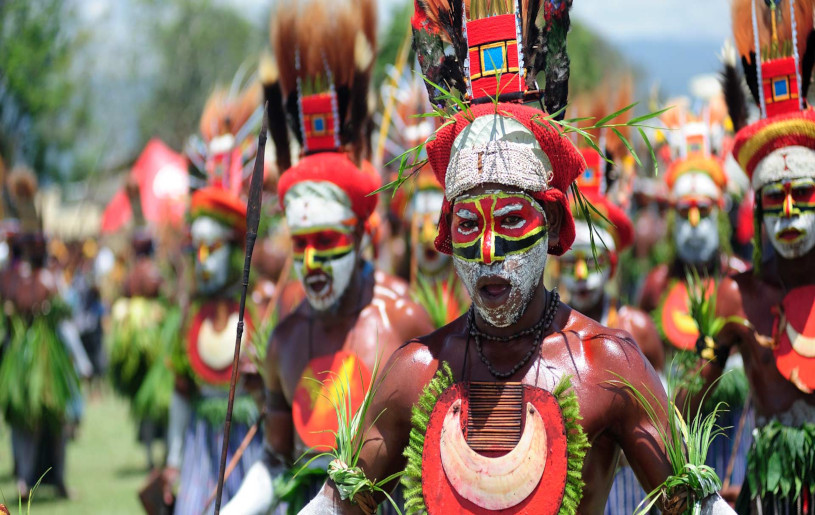
A lot of people are probably aware of Papua New Guinea, that wild island full of fascinatingly remote tribes, countless languages and an utterly unique culture. When you look at it on the map though… It’s a little off, right? Why’s it bisected so perfectly? What even is that western half anyway? That would happen to be West Papua, the Indonesian owned half of the New Guinea island. Now if you happened to think it’s weird for a place like New Guinea to share a common culture with Indonesia, don’t worry, you’re definitely not the first!
So why the hell is it like that and what separates them anyway? Even if they didn’t start out partitioned, surely the culture’s diverged in some ways over the years. It’s time to get some answers.
Why are they separate?
We’ve been over this matter before on the above linked blog, but I’ll give a quick refresher. Put short, colonialism happened. Put slightly longer, West Papua was colonized by the Dutch and formed part of the Dutch East Indies, which included the future Indonesia as a part of it. Meanwhile, what later became Papua New Guinea was first colonized by the Germans, then the British, later Australia and ultimately was granted independence by the Aussies in 1975. Before this, the Western half had already been very controversially incorporated into Indonesia as part of the ‘Act of Free Choice.’ So why’d that happen?
Indonesia got their independence and fancied themselves a major player for the non-aligned movement. Neither pro-Soviet nor pro-America in the Cold War, they stood for the colonized countries. Specifically, they felt that all the territory colonized by the Dutch in the Indies deserved to be united under one banner, their banner. This was bad enough under president Sukarno, only becoming far worse under military dictator Suharto, who was far more keen to use underhanded tactics to secure this victory. Put simply, this is why the countries are separate.
Do they share a language?
Put simply, no. The official language of West Papua is Indonesian, with limited recognition for Papuan Malay, a local West Papuan language that has some limited presence in the border regions with Papua New Guinea. Meanwhile the official languages of Papua New Guinea are English, Hiri Motu and a rapidly growing creole language called Tok Pisin, which is perhaps the most widely spoken in the country. There are also well over 800 recognized languages existing within Papua New Guinea, but crossover into West Papua isn’t particularly likely. Linguistically, the countries have been quite rigidly separated due to their history.
How about their governments?
Not even close. For one, West Papua isn’t a country in its own right, it’s a province of Indonesia. While local government certainly has a say in what goes on, they are ultimately controlled by Indonesia and lack their own governmental system. Meanwhile Papua New Guinea has its own government, legislative system and Prime Minister. It is however also a dependency of the United Kingdom, much like Canada or Australia, with British Queen Elizabeth serving as monarch in a largely ceremonial role.
Population?
Hardly comparable at all. Papua New Guinea holds a population of roughly 8.6 million as of 2018, meanwhile West Papua has around 963,000. It is quite likely that this serves as at least part of the reason for the comparative lack of interest in West Papuan independence, seeing it as comparatively little to gain. It is however quite possible or even probable that Indonesian takeover of West Papua led to an exodus eastwards towards Papua New Guinea.
Religion?
Historical context plays a big part in this. West Papua was colonized first and was taken initially by the Dutch, at the time a very religious nation that sent Protestant missionaries around the globe. Even before them, the first explorers to West Papua were Portuguese, who were much the same. Meanwhile, East Papua was seized by Germany, the UK and Australia, comparatively secular nations at the time who would not have pushed religion quite so strongly. As a result, West Papua is around 53% Protestant while Papua New Guinea has a much broader range of religion. Albeit Papua New Guinea still primarily falls in a Christian spectrum, at around 26% Roman Catholic, 18% Lutheran, 12% Seventh Day Adventist, 10% Pentecostal and so on. It is also quite common in Papua New Guinea for Christianity to be combined with local traditional religion as well. Also notable for West Papua is a 38% Islamic population, no doubt owing to the Indonesian influence. By comparison, Muslims are almost nonexistent within Papua New Guinea.
The Economy?
A difficult one to answer. Papua New Guinea’s GDP per capita is $2,504 in 2019 while West Papuan GDP per capita is at $3,510 in 2016. Sounds like West Papua’s doing a lot better. That all rather depends though, because GDP, even per capita, is not any true indicator of economic success or poverty levels. Poverty in West Papua is significantly higher than in other Indonesian provinces despite having a decently high GDP. So why is that? Well, GDP per capita would assume that the citizens are getting an even share of that wealth. In reality, much of this GDP comes from resource extraction that never finds its ways into the pockets of citizens. Meanwhile in Papua New Guinea, nearly 40% of the population lives rather self-sustainable lifestyles in villages with little access to capital of any sort. Both are fast-growing economies, but starting from rather low-down and with some very uneven development.
Well… Can I see for myself?
You sure can. We run tours to both! In 2020, we have tours scheduled for Papua New Guinea (and Bougainville!) in August and West Papua in May.





